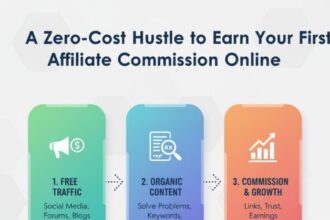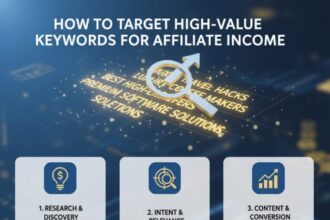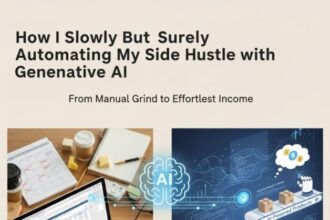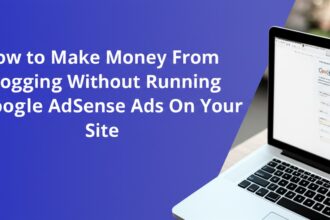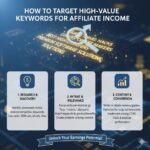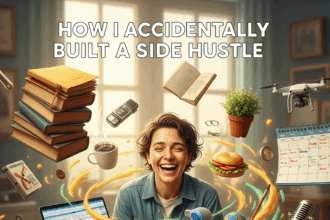A Regular Person’s Guide on How to Create Engaging Content That Attracts AdSense Ads
The clock on my computer screen glowed a malicious 2:17 AM. My coffee had gone cold hours ago, but I kept lifting the mug to my lips out of sheer, dumb habit. My eyes felt like sandpaper.
And then I saw it. The subject line. The one I’d come to dread more than anything.
An Update On Your AdSense Application.
My stomach did a little flip-flop. Not a good one. More like the kind you get when you lean back too far in a chair and realize, for a split second, that gravity has won.
I clicked. I already knew what it would say.
“After reviewing your application, our specialists have found that it does not meet our program criteria…” Blah, blah, blah. Cryptic. Cold. Another dead end.
I didn’t even feel angry this time. Just… empty. I had followed all the rules. I’d read the guides, the top-ten lists, the articles written by smug-looking people leaning against brick walls. They all chattered endlessly about “engaging content.” And I thought I was making it! I really did. Words were being typed. Sentences were forming. It was in English.
So why did it feel like I was sending love letters to a black hole?
I pushed my chair back with a sigh that seemed to drag up from my toes. This whole endeavor felt like trying to solve a Rubik’s Cube in the dark. I was doing everything I was told, and I was getting absolutely nowhere. I had to figure this out. I had to learn how to create engaging content that attracts AdSense ads, not by following another soulless checklist, but by actually understanding it.
So I closed that cursed email. I opened a new browser window, and I prepared to lose my mind. And folks, I did. I tumbled down a rabbit hole so deep I think I saw the Earth’s core.
This is what I brought back.
My First Steps Into This Weird, Maddening World
The first stage of my research wasn’t so much a “stage” as it was a complete and total system shock. Imagine being dropped in the middle of Tokyo with only a high school French dictionary and being told to find the best ramen spot. That was me.
It was an absolute tidal wave of jargon and conflicting advice. Every self-proclaimed guru had their own “secret sauce.” One guy in a ridiculously expensive-looking suit was yelling on YouTube about sales funnels. Another blogger, with a suspiciously perfect minimalist desk, swore it was all about something called “domain authority.”
The noise was just overwhelming. But through the static, I kept hearing the same two phrases over and over. They were the common denominator in all the chaos. And at first, they felt completely useless.
The first was high-quality content.
Okay. Thanks. That’s like telling a wannabe chef to just “cook delicious food.” It’s the goal, not the instruction! What does “high quality” even mean? Seriously, who gets to decide? Is there a panel of judges somewhere? It felt so vague, so utterly subjective, that it gave me nothing to hold onto. My early articles were, in my opinion, pretty good. They just weren’t connecting. Why?
Am I a Bad Host? The User Experience Puzzle
The other big, scary phrase was user experience. Oh man, did I get this one wrong.
I heard “user experience” and immediately thought, “Okay, my website has to look pretty.” So I did what any rational, sleep-deprived person would do: I spent three solid days debating between fifty shades of off-white for my background color. I fiddled with my logo until my eyes crossed. I even read an article about the “psychology of fonts.”
Turns out, my users did not care that I chose “Lato” over “Roboto.” Not one bit.
It took me ages to realize “user experience” isn’t about being an interior decorator. It’s about being a good party host.
Think about it. When you throw a party, you don’t just unlock the door and wander off. You greet people. You show them where the drinks are. You make sure the music isn’t too loud. You make it easy and comfortable for them to be in your space. My website was like a party where the host was hiding in the bathroom, hoping nobody would talk to him. It was awkward. I was making my guests do all the work.
This simple change in perspective—from “designer” to “host”—was the first crack of light in the darkness. My blog wasn’t just a place to dump my thoughts. It was a space I was creating for someone else. And my primary job was to make them feel welcome and help them find what they came for. Suddenly, it wasn’t about me anymore. And that was a terrifying, wonderful relief.
The Cringey Camera Blog Incident
I should probably confess something. My first serious attempt at this was a blog about vintage film cameras. I’m a total nerd for them. I love the weight, the mechanical clack of the shutter, the whole process. I thought, “The experts say write what you’re passionate about!”
So I wrote. And I wrote. I wrote these long, flowery love letters to my favorite cameras. I waxed poetic about film grain and lens flares.
And precisely seven people read it. I think five of them were my mom on different devices.
The passion was real, don’t get me wrong. But my passion wasn’t solving a problem for anyone but me. Nobody was hopping onto Google to search for “some guy’s misty-eyed nostalgia for the Olympus OM-1.” They were searching for practical things. Things like, “How to fix a light leak on an Olympus OM-1” or “best 35mm film for portraits.”
My readers had a mission. They were trying to do something. And my self-indulgent posts were about as helpful to them as a chocolate teapot. I was offering abstract art to a person who needed a user manual. That website is still out there somewhere, floating in the digital graveyard. It’s my constant reminder that passion isn’t enough. Not even close.
Turns Out, a Lot of What I “Knew” Was Wrong
Once my brain started to re-wire itself around this “be helpful” idea, I began to see something else. I began to see that the internet is absolutely stuffed with bad advice.
So much of it feels like a game of broken telephone that started back in 2010. One person had an idea, wrote it down, another person copied it, a third person summarized the copy, and now we have “common knowledge” that’s a decade out of date.
It was infuriating. I felt like I’d been trying to build a modern car using a manual for a horse and buggy. It also felt great. It meant that my failures weren’t just because I was an idiot. They were because I was following bad instructions.
Unlearning is way harder than learning.
The Ghost of Keywords Past
Okay, let’s talk about keyword research. In the old days, from what I can gather, this meant picking a word and then battering your reader over the head with it.
I did this. I’m not proud of it. I wrote an article about “best budget coffee makers,” and I think I used the phrase “best budget coffee makers” so many times it lost all meaning. The article read like it was written by a hypnotist with a caffeine addiction. It was awful. I thought I was doing cutting-edge SEO.
But here’s the kicker: Google isn’t a dumb machine anymore. It’s scary smart. It understands context. It knows what a topic is about. It knows that an article on coffee makers will probably also include words like “carafe,” “filter,” “grinder,” and “brand.” It doesn’t need me to chant the magic phrase a hundred times.
This was huge. It meant I could stop trying to write for a robot and start writing for a human again. I could just focus on covering a topic really, really well. And funnily enough, when I did that, the important keywords just sort of showed up naturally. Go figure.
That Whole “Niche Down” Thing Can Be a Trap
Everyone tells you to do niche selection. “Niche down until it hurts!” they say. So you end up with a blog about “underwater basket weaving for left-handed people.”
I get the theory. You want to be a big fish in a small pond. But there’s a flip side nobody talks about: some ponds are just puddles. They’re so small that there are no fish in them at all. Or, more importantly, no advertisers.
My vintage camera blog was a super-niche passion project. The problem? The companies selling stuff for those cameras are tiny, often just one person working out of their garage. They don’t have a multi-million dollar advertising budget to throw at Google AdSense.
This was a bitter pill to swallow. It meant that passion wasn’t the only ingredient. It had to intersect with profitability. As this piece from HubSpot points out, you have to find the sweet spot between what you love, what readers want, and what advertisers will pay for. I had to find a topic that I could at least be deeply curious about, that a real audience was looking for, and that was connected to an industry that actually spent money. It felt a bit like selling out, at first. But I’ve come to think of it as just being realistic. You can’t help anyone if your website doesn’t exist.
“You Must Be a World-Renowned Expert!” Uh, No.
This was the myth that almost made me quit for good. The voice in my head—which sounded suspiciously like a skeptical high school teacher—kept saying, “Who are you to talk about this stuff? You don’t have a degree in this! You’re a fraud!”
Imposter syndrome is a beast. But then I had a realization. I don’t need to be the planet’s leading expert. I just need to be one step ahead of my reader.
Think about it this way: if you spend an entire weekend obsessively researching the best running shoes for bad knees, you are now a temporary expert. You’ve read the reviews, you’ve watched the videos, you’ve compared the specs. You know more than someone who is just starting their search. You can be their scout. You can report back from the trail ahead and tell them what you found.
Your value isn’t your certificate on the wall. Your value is your hard work. You are a curator, a filter, a human being who has sifted through the garbage so your reader doesn’t have to. Embracing my role as “passionate researcher” instead of “world-class guru” was incredibly freeing. I wasn’t pretending anymore. I was just sharing my notes. People respond to that honesty. It’s real.
The Lightbulb Moment That Finally Made It All Make Sense
For all those months, I was treating my blog and AdSense like some sort of art project. I thought if I created something “good,” “artistic,” or “clever,” the Google gods would float down from their server farm in the clouds and bless me with passive income.
I was thinking about it completely backward. My honest-to-goodness lightbulb moment came on a Tuesday afternoon while I was eating stale crackers. I suddenly stopped thinking of Google as a mysterious art critic and started seeing it for what it is: a brutally efficient business. It’s a matchmaker.
AdSense is not a prize. It’s not a trophy. It is a marketplace. A strip mall. And my blog? My blog is just a storefront in that mall.
My Job Title Is “Landlord,” Not “Artist”
This one simple idea was the key that unlocked everything for me. It re-framed my entire purpose. My job was not to be a brilliant author. My job was to be a good landlord.
My job was to build and maintain a piece of digital real estate so clean, so helpful, and so popular that other businesses would want to rent ad space there. That’s all AdSense is. Advertisers—like Nike or Sony or whatever—pay Google to put their ads in front of the right people. Google, the master matchmaker, then looks for real estate (my blog!) where those people are hanging out.
All those cryptic AdSense policies? They’re not weird, arbitrary rules. They’re the terms of my lease agreement. If I want to be a tenant in Google’s mall, I have to keep my storefront clean and follow the rules. Breaking them is like putting a giant inflatable clown on my roof. The landlord is not going to be happy. For anyone serious about this, actually reading the official policies isn’t a chore; it’s just business 101.
What makes a good storefront? It’s relevant. If a person is on my site reading an article about how to find cheap flights to Italy, and they see an ad for a hotel in Rome? That’s a win-win-win. The reader is happy. The hotel advertiser is happy. And Google, the matchmaker, gets paid. My job is to create that perfect context.
I Finally Understood My Role in the System
This might sound a little bleak, but it’s the absolute truth. The content is not the final product.
My reader’s focused attention is the product.
My role is to earn and hold that attention. I have to create a space that is so genuinely helpful and easy to navigate that people choose to spend their time there. That time, that focus, that “engagement” is the commodity that I, as the landlord, bring to the marketplace.
This changed every single decision I made. It wasn’t about me anymore. It was about them. Does this sentence add clarity? Does this image make the concept easier to grasp? Does this stupid joke I want to make actually serve the reader, or is it just for me? (I still leave some of the jokes in.)
It became a full-blown obsession with serving the reader. Providing a service. If you’re curious about some of my early, failed attempts to provide a service, you can read my post about [lessons from my first three failed blogs]. It’s a bit of a train wreck, but an educational one.
My Weird, Cobbled-Together Guide to Actually Doing This Thing
So after all that misery and all those cold cups of coffee, what does my process actually look like now? It’s not some sleek, patented system. It’s more like a series of rituals I perform to keep myself sane and on track. It’s my content strategy, I guess.
This is just what I do. It’s what took me from staring at rejection notices to finally, finally seeing that beautiful, glorious green “Your site is ready to show ads” message.
Step 1: I Put on My Detective Hat, Not My Writer’s Cap
I almost never start with an idea for an article anymore. That’s a trap. I start with a problem. I become a private investigator for people’s needs. I lurk in the dark alleys of the internet—places like Reddit, Quora, and the bottomless pit of YouTube comments.
What are people complaining about? What are they confused about? What questions pop up over and over again? The “People Also Ask” box on a Google search results page is my treasure map. It’s a literal list of the problems people are trying to solve right now.
My goal is to find a cry for help. I’m not looking to target a big, generic keyword like “home repair.” I’m looking for the desperate, specific query like, “Why does my sink make a weird gurgling noise at night?” One is a category. The other is a human being looking for an answer. My whole job is to answer them. A detailed guide from Semrush on finding these questions was a game-changer for me early on.
Step 2: I Build It for the Skimmers First
This one hurt my writer’s ego at first, but I’ve learned to accept it. People don’t read online. They hunt. They scan. They’re like Velociraptors looking for that one specific piece of information they need.
My job is to make my content easy prey. I structure everything for the person who is in a massive hurry.
You’ll notice I do this here:
Insanely short paragraphs. It’s just easier on the eyes. It feels less intimidating than a wall of text.
Bolding for emphasis. I highlight the main point of a section. You could literally just read the bolded sentences in this article and get the gist. That’s on purpose.
Subheadings that tell a story. They’re not just labels; they’re signposts that guide the reader along the path.
Lists and bullets. The human eye is drawn to them like a moth to a flame. They promise quick, organized info.
My design philosophy is “clarity over cleverness.” I learned a lot about this from the principles of web accessibility, which basically argue that making your site easier for everyone to use is just good design, period.
Step 3: Give Away the Answer Immediately
Remember writing papers in high school? You had to build your case slowly, with an intro, three body paragraphs, and a conclusion.
You must do the exact opposite online.
You have maybe three seconds to convince your reader that you have the answer they’re looking for. Don’t make them wait. Don’t hide the good stuff at the end.
If the title of my post is “The Easiest Way to Peel a Hard-Boiled Egg,” the very first sentence is going to be something like, “The secret is to put the egg in an ice bath right after you cook it; the shell will slide right off.”
See? I’ve already delivered on my promise. I’ve respected their time. Now, they are far more likely to stick around for the “why” and the other tips I might have. It builds trust.
Step 4: I Aim to Be the End of Their Search
Once I’ve earned a few more seconds of their attention, my next goal is to build the ultimate resource on that one, tiny, specific topic. I try to make my article the last click they need to make.
If I’m teaching them how to peel that egg, I need to anticipate their next questions. What if the yolk turns green? How long should I boil it for in the first place? Can I make them in an air fryer?
My process involves mapping out all those potential follow-up questions and building the answers right into the article. I want them to leave my page feeling completely satisfied, like they just ate a full meal. That depth is what drives valuable website traffic<span class=”ng-star-inserted”> over the long haul. And honestly, it feels good knowing you really helped someone out. You can even read about my philosophy on this in my post titled [Going Deep, Not Wide: My Approach to Content That Works].
So, Where Does All This Leave Me?
Look, I’m not writing this from a yacht. I haven’t “cracked the code” in a way that lets me retire next Tuesday. That’s the kind of stuff the gurus sell you. This is the reality.
But what I can tell you is this: that cold dread I used to feel when I saw an email from Google? It’s gone. I get it now. I see the Matrix.
It’s not about magic or luck or being a genius writer. It’s a system. And the entire system is built on one simple, surprisingly profound idea: just be useful. Be a human being who is genuinely trying to help another human being.
My entire long, painful, brain-melting journey was about one thing: getting out of my own way. It was about shifting my entire focus from “What do I want to create?” to “What do they need to solve?”
It was humbling. It was frustrating. It required me to delete a lot of work I was once proud of. But it worked. And the real prize wasn’t the AdSense approval. It was the feeling of finally understanding. It was the ability to look at this huge, confusing digital world and see a path forward.
I’m still on that path, just like everyone else. I’m still figuring things out. But for the first time, I don’t feel lost anymore.
And that, I think, is the most engaging content of all.
